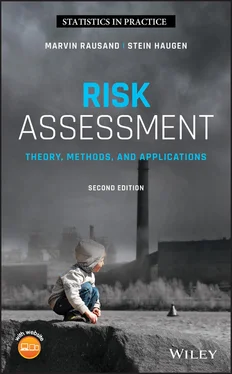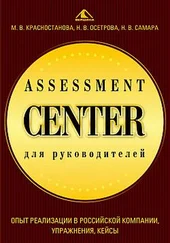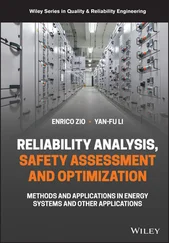Because a worst‐case accident scenario often has a remote probability of occurrence, a more credible accident scenario may be more relevant.
Definition 2.5 (Worst credible accident scenario)
The highest‐consequence accident scenario identified that is considered plausible or reasonably believable (Kim et al. 2006).
The terms “plausible or reasonably believable” are not defined, but Khan and Abbasi (2002) suggest that credible accidents are those that have a probability of occurring greater than  per year.
per year.
Hazard is a commonly used term in connection with risk analysis.
A source or condition that alone or in combination with other factors can cause harm.
We are always surrounded by hazards, but a hazard is not critical until it comes out of control or is triggered one way or another. The event where a hazard comes out of control is an initiating event in the way that we define it below. Hazards can therefore be seen as a primary cause of an initiating event. A hazard can be related to a property of a system or a material (e.g. flammability or toxicity), it can be a state (e.g. gas under pressure, potential energy in an object that has been lifted) or it can be a situation (e.g. a train traveling at high speed). Accident scenarios may involve several hazards, creating domino effects or escalating situations, as illustrated in Example 2.2.
Example 2.2(Accident scenario involving more than one hazard)
A possible accident scenario may comprise the following events:
1 (a) A car driver loses control over her car on a road.
2 (b) The car moves over in the opposite lane.
3 (c) A truck coming in the opposite direction tries to avoid collision and swerves off the road.
4 (d) The truck topples over.
5 (e) The truck carries petrol that is spilled.
6 (f) The petrol ignites, causing a large fire.
In this case, several hazards can be identified: The speed (kinetic energy) of the first car, the speed of the truck, and the petrol in the truck.
The term “hazard” is widely used in many different ways in connection with risk assessment. The systematic methods that we use to answer the question “what can go wrong?” are often called “hazard identification methods,” even if it is initiating events or hazardous events that are identified.
Many hazards are related to energy defined in a very wide sense. Examples are mechanical, thermal, or electrical energy. Table 2.3lists some hazards together with brief comments, to further illustrate the definition of hazard.
Table 2.3Examples of hazards.
| Hazard |
Comment |
| A car |
A stationary car can be a hazard if it is located on top of a hill (in a specific state) and can start rolling (releasing potential energy). It is also a hazard because it contains fuel that represents thermal energy (a property of the material) that can ignite or explode. There is also electrical energy stored in the battery. A moving car represents an additional hazard because it has kinetic energy. |
| Propane gas under pressure |
In this case, both the state (under pressure) and a property (flammable) represent hazards associated with the propane. |
| Water in a hydroelectric power dam |
It is the water that is stored that is the main hazard in this case. The water contains massive amounts of potential energy and if the water is released this may cause severe damage. The dam itself can also be regarded as a hazard, but then just locally, because it can collapse and kill people nearby or damage equipment. |
| Ammunition for a gun |
According to the definition, it is the gunpowder that is the hazard. It is the thermal energy in the gunpowder that makes it expand rapidly and fire the bullet. Pulling the trigger on a gun that is loaded is the initiating event that releases the energy. |
| A large crowd in a confined space |
A full football stadium can be seen as a hazard. Some unexpected event can lead to panic and trigger rapid evacuation. This is a situation that can cause injuries and even fatalities. |
| Tension between tectonic plates |
It may seem strange to define this and not earthquake as a hazard, but the earthquake is the event that follows from release of the energy that is otherwise under control (at least temporarily). |
| Pressure differences in the atmosphere |
This is also an unusual definition and in most cases storm would be seen as the hazard. Similarly to earthquake, storm is the event that results from the pressure difference. |
| Tension in an offshore structure |
The initiating event in this case could be “structural collapse,” caused by the tension in the structure exceeding the load‐bearing capacity. |
Some of these hazards may seem counterintuitive and needlessly formal. In practice, the term “hazard” is used in many different ways and often without any clear definition. We come back to this issue in later chapters.
2.3.3 Initiating Event and Hazardous Event
Before defining initiating event, we give a general definition of the term “event”:
Incident or situation that occurs in a particular place during a particular interval of time.
In risk analysis, the term “event” refers to a future occurrence. The duration of the event may range from very short (e.g. an instantaneous shock) to a rather long period. An initiating event is defined as follows:
Definition 2.8(Initiating event)
An identified event that represents the beginning of an accident scenario. (Adapted from IAEA 2002 .)
This definition states that the initiating event represents the beginning of an accident scenario, but it is not clearly specified where and when the beginning is. In Example 2.1, we said that “gas leak from flange A” was the beginning of the accident scenario, that is the initiating event, but we do not say anything about why the leak occurred. If this was because of an impact against the flange, we could have said that “impact against flange A” was the initiating event. In practice, it is up to the risk analyst to decide what she wants to define as the beginning. This depends on what the focus of the analysis is, the limitations of the analysis, limitations in our knowledge about the system or the accident scenarios, and so on. Among the causes of initiating events are hazards.
Another commonly used term is hazardous event, sometimes used more or less synonymously with initiating event. We have chosen to distinguish these two, although it is not easy to give a precise definition of hazardous event. A possible definition is:
Definition 2.9 (Hazardous event)
An event that has the potential to cause harm.
From this definition, any event that is part of an accident scenario, including the initiating event, may be classified as a hazardous event. The practical use of this term is discussed under methods for hazard identification in Chapter 10.
Observe that both initiating event and hazardous event are terms that are difficult to give a precise physical meaning. Instead, both can be regarded as analytical terms that are used to identify starting points for the analysis. Because the starting point of our analysis may be chosen more or less freely, it is not possible to pinpoint specific events in a sequence that are initiating and hazardous events, respectively. As a guideline, it may be useful to specify the hazardous event as the first event in the sequence when the situation moves from a normal situation to an abnormal situation. This is not necessarily very precise, but may still be a help in performing risk analyses in practice.
Читать дальше

 per year.
per year.










